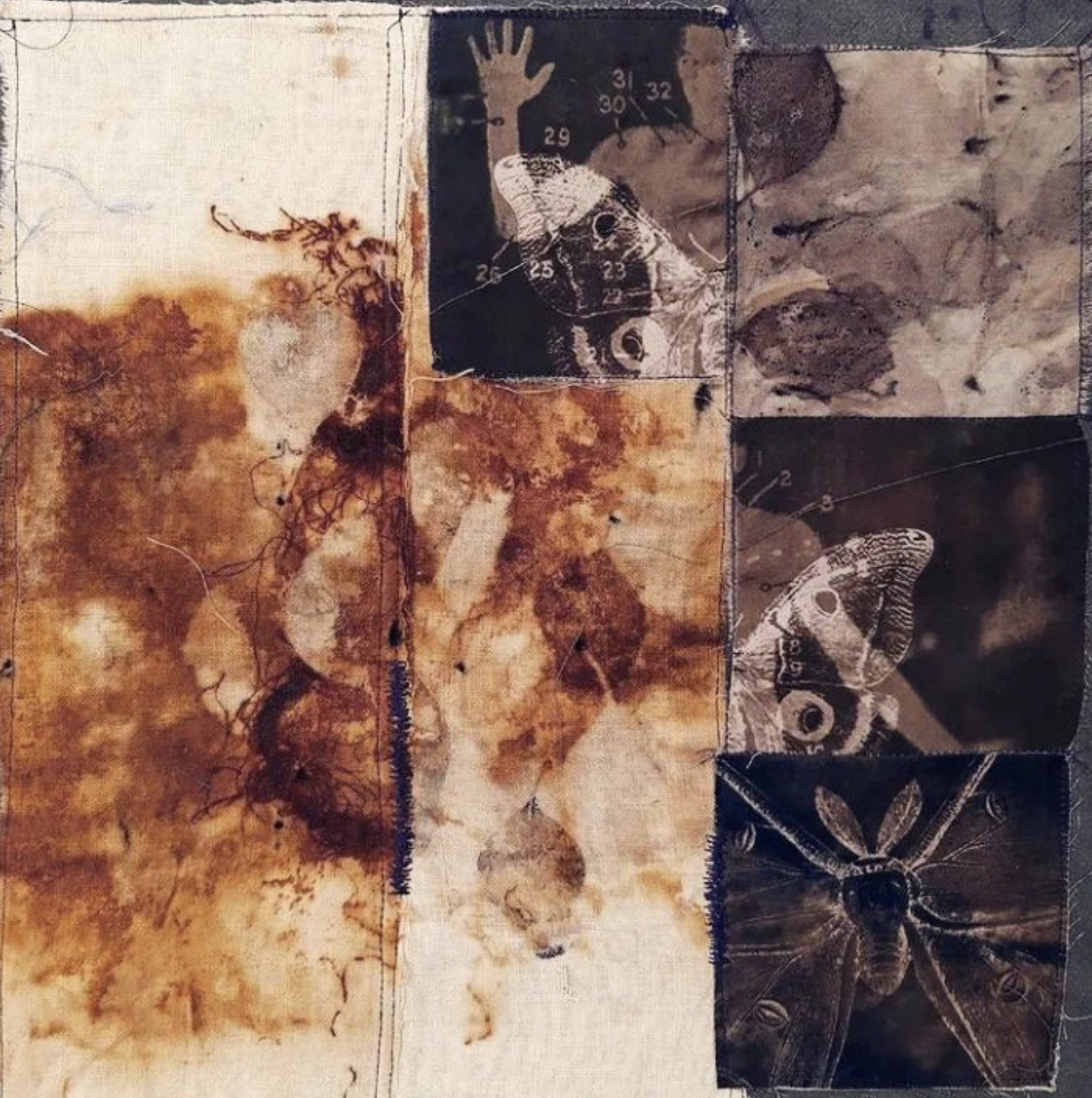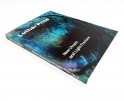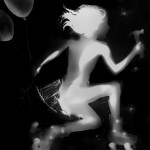Contemporary Approaches in Historical Processes: Douglas Pierre Baulos
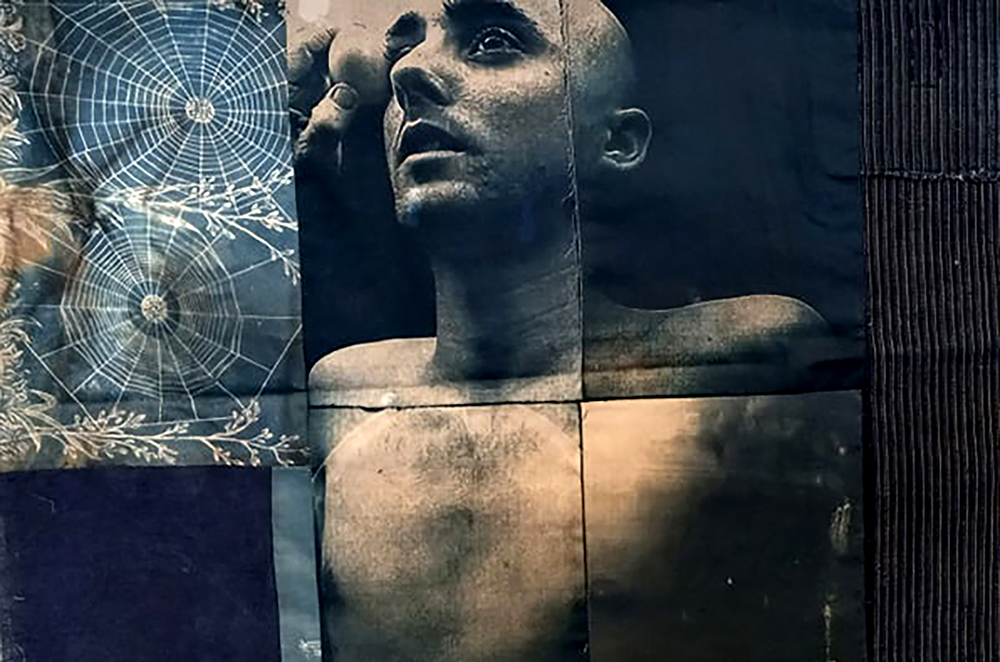
©Douglas Pierre Baulos, “Stars are holes” over dyed found linen, cyanotype, kasuri, indigo, salt, iris root dye, found cloth, thread. 18” x 27”
How does modern alternative process differ from traditional uses of historical process? This week, all of the artists that we are featuring use historical processes with very contemporary approaches. Some of the artists alter the chemistry. Others combine their chosen process with other techniques, not only breaking the rules but opening up more possibilities to define contemporary alternative process.
I am pretty sure the work of Douglas Pierre Baulos popped up in my Instagram feed last summer. I wondered how I hadn’t seen this work before with its many wonderful combinations and layers. The work sometimes feels psychological because of the overlaying of natural things, and at other other times it feels more scientific because of the the medical illustrations. The tension created by these combinations almost seems to question the meaning of the human experience. If someone doesn’t have the ability to express themselves, then how can they ever be whole?
This work is a collection of beautiful narratives about identity. It explores the complex feelings, concerns and mortality of a queer, nonbinary artist. They create cyanotypes and anthotypes that are layered, abstract and fragmented. Using symbolism from the natural world they are stitched together, intersecting images and creating narratives. These images are a part of a larger installation that includes Douglas’ drawings, handmade paper, natural dyes and ceramic pieces; all come together as an intimate and immersive experience.

©Douglas Pierre Baulos, “Moth Sheet” over dyed found linen, cyanotype, eco-printed found linen indigo, salt, acorn cap dye, found cloth, thread. 22” x 43”
Douglas Pierre Baulos was born in Springfield, Illinois. In 1990, they received a Bachelor of Fine Arts from the University of Alabama at Birmingham. In 1993, they received a Master of Fine Arts from the University of New Orleans. They are an Associate Professor at the University of Alabama at Birmingham. Their drawings, installations, and photos objects have been exhibited/published both nationally and internationally. Doug’s current works are explorations (visual) and meditations (poetry) centering on their ideas of spirituality, love, death, shelter, and hope.
Follow Douglas Pierre Baulos on Instagram @ doug_baulos

©Douglas Pierre Baulos, “They/Them/Transform” over dyed found linen, cyanotype, found cloth, thread. 13” x 19”
Although I work with the feelings of loss, mortality, and the power and delicate nature of memory, my work reflects my attempt to live my life in fragile exultation. Most of my recent photo and cloth work reflects a multitude of interests including grief, mending, and spirituality. My work is composed of myriad layers of processes, ideas, and associations about my queer identity. Taking photographs and piecing together an image is a meditative exercise for me having as much to do with duration as physical texture or of following the thread of mindfulness. I merge the abstraction of narrative with the physicality of object. I want to personify intangible experiences and feelings and make them tangible for my audience. There is an intimacy with the subject becoming object, with the reverence for the past life and the confrontation of the doggedly present body. I primarily use cyanotype and natural dye toner processes for image making and I try to be very aware of how events are traced and mapped both physically and emotionally (how I decide to dye and tone) – both violent and non-violent (passive). Recently I’m exploring the idea of simultaneously linking my photographic cloth stories and installations with inner experience, seeking to create works that present themselves as humble objects that open into vast, imaginative space for the viewer. Several of the installations I have shown in 2022have been large – 17 to 43 feet long. I hope to explode the ideas in my work into an embodied narrative, an environment of shared inner life and concerns.My current work explores how I and many other queer and non-binary artists use the natural world to navigate difficult feelings and often are still much more prone to have mental illness issues and suicidal thoughts. My goal is to make work that fosters more opportunities for inclusion and safety of LGBTQ people in nature. Growing up queer in Alabama, I sacrificed authenticity to minimize humiliation and prejudice. As an artist and researcher, I try to dive as deep as possible into my technical and conceptual interests and hope to point out missed opportunities for inclusion while exploring and articulating wide implications of different gendered identities. As someone that uses a camera and maker, I hope to instill joy at the beauty of the world, which for queer people, can be an act of resistance. – Douglas Pierre Baulos
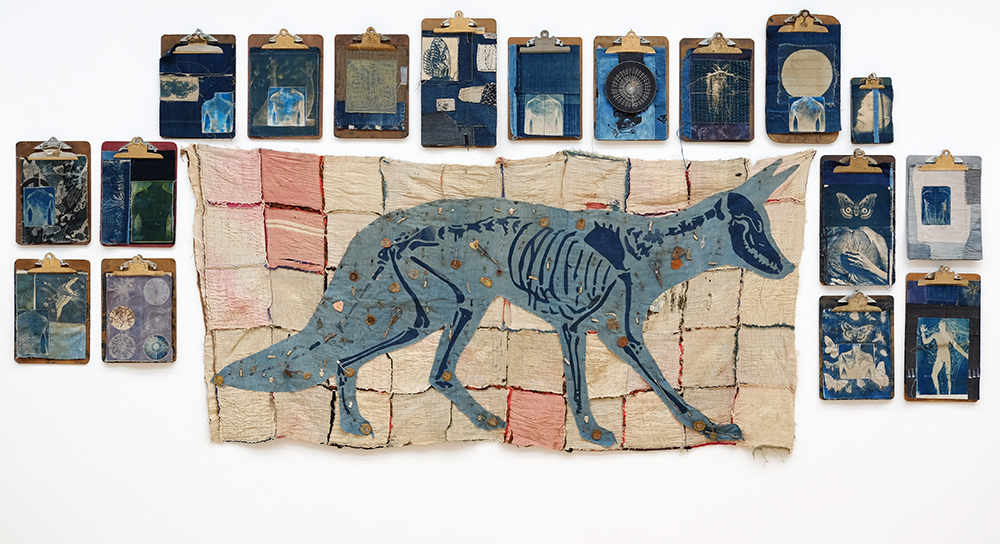
©Douglas Pierre Baulos, “Things Look Different from Far Away” (detail) over dyed found linen, cyanotypes, found objects, indigo, salt, handmade paper, found cloth, thread. 43 ft wide x 17 ft high x 14 ft deep.

©Douglas Pierre Baulos, “Doorway” over dyed found linen, cyanotype, acorn tannin indigo, salt, thread. 6.8” x 10”
Greg Banks: Tell us a little bit about your childhood and how you became an artist? How did photography become a part of your work?
Douglas Pierre Baulos: I have drawn and taken photos from a very young age. My parents gave me a brownie camera and a photo developer kit when I was 7. I use drawing and photography to create meaning both in my relationship to the world and my studio practice. I like the magic of capturing light in a box and having an alchemy lab of sorts in my studio. Especially in the last 10 years I have really pushed experimenting with photo processes and my dye garden.

©Douglas Pierre Baulos, “Doorway” over dyed found linen, cyanotype, acorn tannin indigo, salt, thread. 6.8” x 10”
GB: Talk about being a queer person in the south and how you hope to elevate the conversation to help other southern LBGTQ people?
DB: As a queer and non-binary artist in the deep south, I use the natural world to navigate difficult feelings and exploring why often I’m still prone to having mental illness issues and suicidal thoughts. I’ve lived all over before moving to Alabama and always wondered how I could simultaneously link my outer experience in the natural world with the complicated feelings of my inner experience as a queer artist. I’m about to publish a workbook/catalog titled “Things shouldn’t be so hard” which is funded by the Verdant Fund and the Andy Warhol Foundation which will reveal under reported and consequently marginalized concerns I have as a specifically southern queer maker that has lived in Alabama for over 30 years now – while also allowing the reader to identify their concerns. The workbook will be both a catalog and provide immersive prompts and creative opportunities to explore the readers relationship with the natural world.

©Douglas Pierre Baulos, “Tung Leaf” over dyed found linen, cyanotype, indigo, salt, acorn cap toner, thread. 14” x 21”
GB: You have said you are grateful to be in Alabama which I think would surprise a lot of people. How does being in the state inform your work?
DB: I love Alabama and that love has been a journey that is deep and complicated– I often talk about the state as if it’s a suitcase that I need to pack and unpack and reorganize on an almost daily basis. As a gay person in the south, I often sacrifice authenticity to minimize humiliation and prejudice. As an artist and teacher, I try to dive as deep as possible into my technical and conceptual interests. As a maker, I make work that hopes to instill joy and fragile exultation at the beauty of the world, which can for queer people be an act of resistance. Since Alabama is currently the fourth most biodiverse state in our nation, it provides amazing resources and opportunities and inspiration for me. All my current research and questions in the studio are centered around creating a magical an endemic familiarity with Alabama natural dyes/inks and photo toner agents and materials to establish a deep sense of intimacy and reverence for the viewer

©Douglas Pierre Baulos, “Under the Moon” over dyed found linen, cyanotype, pokeweed toner, indigo, salt, walnut ink, found cloth, thread. 24” x 39”
GB: How and why does the natural world play a role in your work?
DB: From an expanded materials perspective, I use a lot of natural dyes and natural materials that I grow or sustainably harvest to geo psychologically explore the part of Alabama I live in. Conceptually I love using mostly endemic materials from my state to create stories about the people and things I love in Alabama. I have never been great with distance so most of my work if really focused on what is happening near me or things that have remained near in my heart. I also hope that as an eco-poetic artist, I pose unexpected question that might otherwise go unasked. By focusing on the connections where scientific understanding, emotional experience, and diverse realities exist, I hope to inspire wonder and reverence for the natural world of Alabama specifically. As a queer artist, I hope to create unorthodox, fugitive, and liminal works and object experiences that when exhibited, showcase my concerns about mortality, shelter, and ecology.

©Douglas Pierre Baulos, “Envoy Refrain” over dyed found linen, cyanotype, kasuri, indigo, salt, iris root dye, found cloth, thread. 11” x 14”
GB: Talk more about your process and how you combine everything from found objects, drawing, photography, ceramics and even fibers and sewing in your large installations?
DB: In my most recent large installations, I’m creating immersive experiences (over 20 feet) to create works that present themselves both as humble objects (small photos combinations) that open into vast, imaginative space for the viewer. I hope to explode the subjects in my work into an embodied narrative, a liminal experience of shared inner life and concerns. I use the warmth and familiarity and tactile nature of paper, cloth, and images of my friends to make work with as deep sense of intimacy and reverence.
I specifically want my work to complicate place in Alabama in the hopes that I can create works with a deep sense of intimacy with cloth, reverence for the environment, craft, recycling processes, mending, and sewing as a form of meditation. By studying medical and suture sewing along with traditional sewing stitches I form new types of intersectional material relationships that combine with forms of stacking, folding, insetting, and other types of cloth and paper engineering to form new types of narratives. I often create/draw/print/stack very different types of negatives when exposing images. I merge the abstraction of narrative with the gravity and physicality of found and created objects. I use mostly cyanotypes and anthotype like emulsions processes because of their ability to work in combination with found fibers, handmade paper, and natural dyes, which I often combine. For me, expanding and combining my studio practice with photo, cloth, mending, and ceramic objects into installations is a way of reaching deeper into myself, while simultaneously reaching towards others.
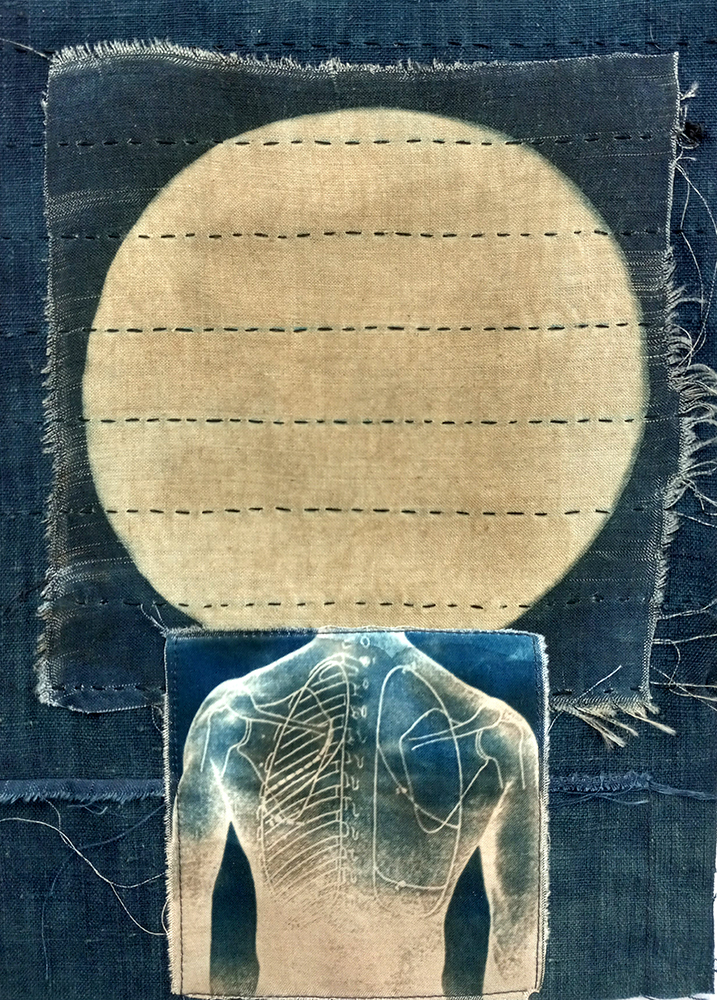
©Douglas Pierre Baulos, “The Veil” cyanotype, indigo, salt, acorn cap toner, found cloth, woad dyed sashiko thread. 8” x 10.”
GB: How do you make associations to decide on the combinations of images that you juxtapose?
DB:I use the term “queering installation” and I realize a lot of LGBTQ people don’t like the currently reclaiming of the term queer but I’ve embraced it – For me, queering and expanding on traditional Installation practices can define new kinds of research questions, and point out missed opportunities for inclusion and suggest how to put nature first as a safe place. Fragments in my work represent the aspects of my identity that didn’t find language or express their wants, desires, or need because I didn’t think it was safe to do so. Fragments are often detached from the core of a victimized person population and become suppressed. Using a taxonomy of different mending and connecting processes I explore and articulate wide-ranging implications of being a queer artist. The creation of my “cloth stories” helps me communicate/combine images and feelings and relation to place in effective and provocative ways.
Posts on Lenscratch may not be reproduced without the permission of the Lenscratch staff and the photographer.
Recommended
-
Luther Price: New Utopia and Light Fracture Presented by VSW PressApril 7th, 2024
-
Artists of Türkiye: Sirkhane DarkroomMarch 26th, 2024
-
European Week: Sayuri IchidaMarch 8th, 2024
-
European Week: Steffen DiemerMarch 6th, 2024
-
Rebecca Sexton Larson: The Reluctant CaregiverFebruary 26th, 2024


